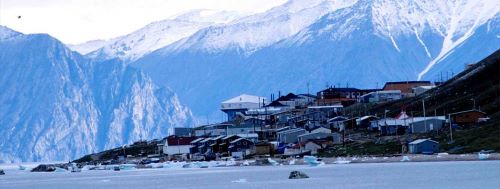National research strategy and Indigenous-led research stations needed in Canada’s North: report
 Canada needs a national strategy to coordinate Arctic and Subarctic research and build capacity and infrastructure in the North – including Indigenous-led research and new Indigenous-operated research stations, says the country’s chief science advisor.
Canada needs a national strategy to coordinate Arctic and Subarctic research and build capacity and infrastructure in the North – including Indigenous-led research and new Indigenous-operated research stations, says the country’s chief science advisor.
 “We don’t really have a clear strategy that sets out for everyone the elements that we want to address in our Arctic or in our polar research, whether in our own Arctic or also as being important members of international networks,” Dr. Mona Nemer, PhD (photo at left), told Research Money.
“We don’t really have a clear strategy that sets out for everyone the elements that we want to address in our Arctic or in our polar research, whether in our own Arctic or also as being important members of international networks,” Dr. Mona Nemer, PhD (photo at left), told Research Money.
There are gaps in the centralized “hub-and-spoke” research network currently operating in the Arctic and Subarctic regions, and a more integrated, flexible and diverse distributed research network is required, Nemer said.
“We need to establish this clear strategy for harmonization and coordination, and that’s something very different from a physical hub.”
The lack of coordination of Arctic and Subarctic research is seen as an important challenge by many actors of the research system, according to a new report by the Office of the Chief Science Advisor.
Greater scientific progress can be achieved by building on a shared long-term vision, common priorities, coherent and concerted efforts to support both the research projects and their logistical needs, says the report, “The Polar Continental Shelf Program and the Rapid Rise of Northern Research.”
Greater cooperation between institutions that support research in the North, which may be anchored in a shared strategy, could help move towards that goal, the report says. “Collectively, the growing network of northern infrastructure and logistical support could be understood (and recognized) as one of the federal government’s major research infrastructure commitments, which could in turn foster more integrated and concerted efforts.”
“We really need to put more emphasis on and enhance the intensity of our research in the North and for polar research in general,” Nemer said.
“This is where having the strategy becomes very important, because there needs to be an infrastructure, planning and a strategy that would accompany the broad strategy for research.”
As part of a national strategy, the report says, there’s a need to support efforts to work more closely with northern communities in order to identify research issues and, where relevant, co-produce the knowledge to address them and help turn the knowledge into community benefits.
With the current hub-and-spoke research network, the hub – which is focused on providing logistics support – can potentially become a bottleneck for the entire Arctic research enterprise, Nemer said.
Also, given the geography of the Arctic with its low population density and widely scattered communities, the physical hub’s location can introduce biases in the type of research done, how it’s conducted and who’s involved in the research, she added. “So basically you have places that are better served than others.”
On the other hand, a distributed research network involves building research stations in various Indigenous communities that would be operated and maintained by local Indigenous residents. Some stations might specialize in certain research that’s important or beneficial to the communities, and/or which would attract different types of research.
“It’s a case where a facility and infrastructure will serve to increase capacity in the North, which is what the Northerners are asking us for,” Nemer said. “I think it will contribute to local development.”
Growing research activity in the Arctic requires new approach
Canada has the world’s second-largest Arctic region, after Russia.
The amount of global scientific activity related to the Arctic has increased 20 times, based on the volume of scientific publication, according to the Office of the Chief Science Advisor’s report. Since about 2000, the growth rate of Arctic-related publications has been about double that of all publications.
The number of Arctic-related publications in 2020 was four times what it was in 2000. If this trend continues over the next 20 years, Northern research alone could increase eightfold by 2040, requiring significant growth in logistical capacity, the report says.
It adds: “Greater economic and military attention may generate investments that could improve telecommunications, energy and transportation infrastructure, which in turn could benefit research and development activities.”
Given that many systems span disciplines and national borders, meeting Arctic research challenges relies on interdisciplinary and international data sharing, ensuring access to documents and data while respecting data sovereignty, including Indigenous data sovereignty, the report says.
Nemer said she recently returned from a trip to Norway, where she was surprised to see the increasing interest in polar research even by non-polar countries such as India, China and South Korea. “A lot of these researchers and countries are interested in coming to our Arctic.”
However, she said that when international researchers want to come here, they have to go through “a maze of understanding” who they should be talking with, who does what, and who gives them the permission for where they will be working.
“It’s in our best interests – and in a way it’s what the world expects of Canada – that we have a strong strategy [for Northern research], not a siloed one,” Nemer said.
However, given the lack of coordination in the Northern research network, the federal government doesn’t even know how many research stations there are in the Arctic and Subarctic regions.
A 2008 report on the Canadian Arctic Research Initiative, by an expert panel of the Council of Canadian Academies, pointed out the need to coordinate efforts between research programs and projects that rely on different types of logistics.
For instance, to study complex interlinked phenomena in the Arctic and Subarctic, a project may require combining access to remote land locations with access to community-based science activities (such as population health or engineering) and ocean- or space-based logistics.
“It is unclear how coordination across these logistical streams would currently occur,” says the Chief Science Advisor’s report.
Given the growing participation in Arctic research and how rapidly the Arctic climate is changing, Canada needs to have local capacity on the ground to do the research, Nemer said. This includes such work as monitoring biodiversity loss, retreats of glaciers, food security for Northerners, and many other things.
“There is no reason why we don’t have proper, state-of-the-art research stations in many different places,” Nemer said.
“Having a proper framework and supporting people wherever they are across the country, whether in government or outside, in terms of Indigenous knowledge, working with Indigenous people, I think it’s something that also would be quite central to a strategy.”
A “champion” will be needed to develop and implement a national strategy
The Polar Continental Shelf Program (PCSP), with a facility in Resolute Bay on Cornwallis Island in Nunavut, provides a hub-and-spoke model of logistics coordination and planning for eligible research initiatives in Canada’s North. But it is just one of many programs and organizations involved in Arctic and Subarctic research.
In addition to the PCSP, researchers can receive support from the Social Sciences and Humanities Research Council, Natural Sciences and Engineering Research Council, Canadian Institutes of Health Research, Canada Foundation for Innovation, and Polar Knowledge Canada to name a few, says the Chief Science Advisor’s report.
This list excludes provincial, territorial and local sources of support. Organizations such as ArcticNet, the Arctic Institute of North America, and PermafrostNet also bring together Arctic researchers studying human health and natural and social sciences in the Arctic.
Research institutions located in the North, such as the Nunavut Research Institute, Aurora Research Institution, and Yukon University in Whitehorse, are playing an increasing role in research and training.
The PCSP, given its history and experience in logistics, is ideally suited to play a leading role in coordinating solutions to logical challenges, to help grow a world-class network of research infrastructures and logistics organizations to further promote and support Arctic and Subarctic research, the report says.
However, the report also points out that research in the Traditional Knowledge Program area accounts for less than one per cent of PSCP-supported projects. Out of 239 PSCP-supported projects in 2019, only two were in the Traditional Knowledge Program. In comparison, PSCP supported the logistics for 111 federal government research projects and 83 projects by Canadian universities.
Northern communities are interested in seeing more research in the area of traditional knowledge but they lack the research capacity, and researchers from southern Canada often misunderstand the value of weaving Indigenous knowledge into Western science, Nemer said.
A national Arctic and Subarctic research strategy could help address what Northern communities want in terms of research, Nemer said. However, leadership will be crucial to develop and implement the strategy, she added. “They need not be necessarily the same organization and the same people.”
The leader and champion for the strategy could be one or two government departments, she said, or perhaps Polar Knowledge Canada (POLAR), which is responsible for advancing Canada’s knowledge of the Arctic, strengthening Canadian leadership in polar science and technology, and promoting the development and distribution of knowledge of other circumpolar regions.
A national strategy with a 10-year horizon and a five-year action plan, for example, “would be much better than what we have now,” Nemer said.
She noted that an I-STEM cluster (Interdepartmental Indigenous Science Technology, Engineering and Mathematics) was launched in 2019 within the federal government. The cluster is a collaboration among several departments to attract and retain Indigenous talent in STEM fields, work within the federal STEM space to educate and train public servants, and foster long-term and reciprocal relationships with Indigenous partners.
Nemer’s office, for example, has an Indigenous scholar-in-residence who’s part of the I-STEM cluster.
Northern communities should be encouraged to create local research bases that yield tangible benefits to local communities, address community questions, and support community-based science, the Chief Science Advisor’s report says.
One way to do this, the report suggests, would be to amend the Scientific Integrity Policy of Natural Resources Canada, which is in charge of the Polar Continental Shelf Program, to include specific provisions for the appropriate solicitation, gathering, communication, storage and use of Indigenous Knowledge that both reflect current best practices and anticipate future challenges.
Nemer said her office has been working with the government’s I-STEM cluster to add some new provisions – including on Indigenous knowledge and artificial intelligence – to the Scientific Integrity Policy, which 22 federal departments have.
As for who will fund new Indigenous community-based research stations in the Arctic and Subarctic, Nemer said she believes companies that work in the North would contribute to specific elements, if asked. But there definitely will need to be government investment as well, she added.
She recalled a visit to the North and Indigenous people telling her they were always happy to see officials with the Department of Fisheries and Oceans arrive from the south in the early summer to test the community’s water and local fish stocks.
But an Indigenous-operated community-based research centre could not only test the water and the fish, it could monitor for biodiversity, changes in local glaciers and sea ice, and do research in other areas, Nemer said.
“I don’t believe that cost should be an impediment, because actually the costs of inaction are going to turn out to be far, far greater on many levels,” she said. “So I don’t see this as a cost. I see it as an investment in the future of the communities there, but also in the present and the future of the country.”
See also: Federal government needs to act now to ensure Canada’s Arctic security: Senate committee
R$
Events For Leaders in
Science, Tech, Innovation, and Policy
Discuss and learn from those in the know at our virtual and in-person events.
See Upcoming Events
You have 0 free articles remaining.
Don't miss out - start your free trial today.
Start your FREE trial Already a member? Log in
By using this website, you agree to our use of cookies. We use cookies to provide you with a great experience and to help our website run effectively in accordance with our Privacy Policy and Terms of Service.





